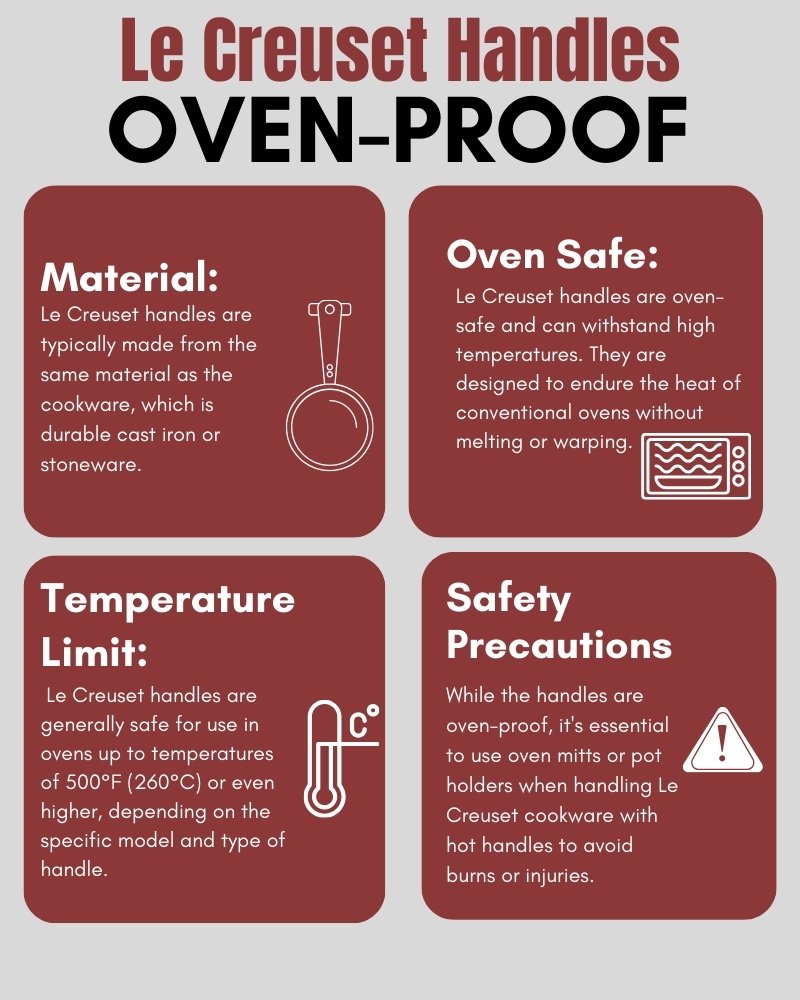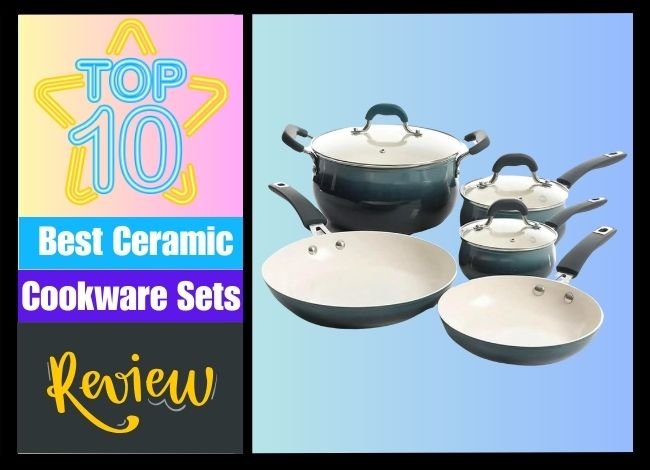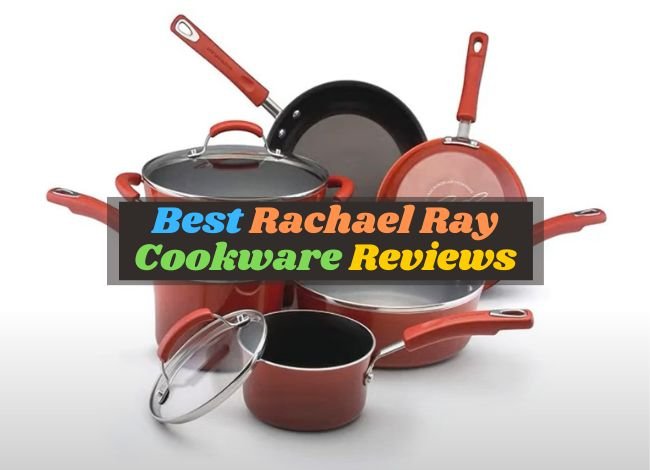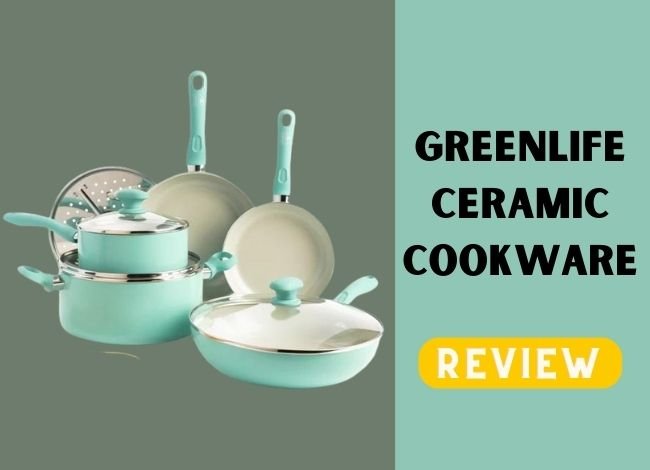Last Updated on February 5, 2024
When it comes to high-quality cookware, Le Creuset is a name that resonates with both amateur cooks and professional chefs. Known for its colorful enameled cast iron Dutch ovens, Le Creuset has established a reputation for producing durable and functional kitchen essentials. A common question that often arises among users is about the oven safety of various components of Le Creuset cookware, particularly the handles and knobs. Understanding these parts’ durability and heat resistance is crucial for safe and effective cooking. This article delves into these aspects, offering clear insights and practical advice for Le Creuset enthusiasts.
Furthermore, is the Le Creuset knob oven safe?
Le Creuset is renowned for its attention to detail, and this extends to the knobs on its cookware. Most Le Creuset knobs are made from either phenolic plastic or stainless steel, both of which are generally considered oven safe. However, it’s important to note that phenolic knobs, which are black and slightly textured, are safe up to 375°F (190°C). For higher oven temperatures, it’s advisable to use stainless steel knobs, which can withstand temperatures up to 500°F (260°C). It’s a small yet significant detail that ensures the longevity of your cookware and safety during cooking.
Related Post: Can you use Le Creuset on an induction cooktop?
Are phenolic handles also safe to use in the oven?
Phenolic handles, found on some Le Creuset products, are designed for durability and ease of use. These handles are oven safe, but like the phenolic knobs, they have a temperature limit. Generally, they can withstand oven temperatures up to 375°F (190°C). This makes them suitable for most baking and roasting tasks. However, for recipes requiring higher temperatures, taking precautions such as removing the lid or using an alternative pot is advisable. Being aware of these temperature constraints is key to maintaining the quality and lifespan of your Le Creuset cookware.
As a result, do the handles on Le Creuset pots get hot?
While Le Creuset cookware is designed for efficient heat distribution, it’s important to note that the handles on these pots can get hot, especially when used on the stovetop or in the oven. The handle’s material, whether cast iron, stainless steel, or phenolic, conducts heat to varying degrees. Therefore, it’s always advisable to use oven mitts or a potholder when handling Le Creuset pots during and after cooking. This practice ensures safety and helps in comfortably managing the cookware during the cooking process.
Is it possible to cook with a Dutch oven cover in the oven?
Using a Le Creuset Dutch oven cover in the oven is perfectly feasible and often recommended for certain cooking methods. The covers are designed to be oven-safe, allowing for a range of cooking techniques such as braising, baking, and roasting. However, it’s essential to consider the oven safety of the knob, as discussed earlier. Ensuring that the temperature does not exceed the recommended limit for the knob material is key to successful and safe oven use of your Le Creuset Dutch oven.
Related Post: Can I use Le Creuset on glass top stove?
What is causing my Le Creuset pan to stick?
If food is sticking to your Le Creuset pan, there could be several reasons. First, it’s important to understand that enameled cast iron cookware requires proper preheating and adequate cooking oil or fat to prevent sticking. Overheating the pan, especially when empty, can also lead to sticking issues. Regular maintenance, including careful cleaning and avoiding abrasive materials, will help maintain the enamel’s non-stick properties. Understanding these factors will help ensure a pleasant cooking experience with your Le Creuset cookware.

Choosing Between Staub and Le Creuset, Which is Better?
When it comes to high-quality cookware, two names often dominate the conversation: Staub and Le Creuset. Both brands are renowned for their durability, heat retention, and aesthetically pleasing designs. Le Creuset, known for its vibrant, enamel-coated cast iron cookware, offers a lighter product compared to Staub’s slightly heavier build. This can be a deciding factor for those who prioritize ease of handling. Staub, however, is celebrated for its self-basting spikes, which ensure even moisture distribution during cooking. Both brands offer excellent heat retention and are compatible with all stove types. Ultimately, the choice between Staub and Le Creuset boils down to personal preferences regarding weight, lid design, and color options.
What is the Best Way to Remove Burned Food Out of My Le Creuset?
Dealing with burned food in your Le Creuset can be challenging, but it’s not insurmountable. Start by filling the pot with a mixture of water and baking soda and bring it to a simmer. This helps loosen the burned food. For tougher stains, leave the mixture to soak overnight. Avoid using harsh abrasives, as they can damage the enamel. Gentle plastic or silicone spatulas can be effective in scraping off the residue. For persistent stains, a mixture of vinegar and baking soda can be applied to form a paste, which after a few hours of application, helps lift the stains. Remember, regular care and gentle cleaning methods are key to maintaining your Le Creuset’s iconic look and functionality.
Related Post: Can Le Creuset stoneware go in the microwave?
What is the Best Way to Remove Scratches Out of a Le Creuset?
Scratches on your Le Creuset cookware, particularly on the enamel surface, require careful handling. Minor scratches can often be buffed out with a gentle cleaner specifically designed for enamel. For deeper scratches, it’s important to assess the extent of the damage – if the enamel is chipped significantly, the cookware might need professional repair or replacement. To avoid future scratches, use wooden or silicone utensils instead of metal, and avoid abrasive cleaners or metal scouring pads. Regular maintenance and careful use can keep your Le Creuset looking pristine for years.
Is it Possible to Use a Magic Eraser on a Le Creuset?
Using a Magic Eraser on a Le Creuset requires caution. While Magic Erasers can be effective for cleaning a wide range of surfaces, their abrasive nature might harm the enamel coating of Le Creuset cookware. It’s advisable to test the eraser on a small, inconspicuous area first. Sticking to milder solutions like warm soapy water or a vinegar-baking soda mix is recommended for routine cleaning. This ensures the longevity and preservation of the enamel’s shine and color without risking damage.
Is it Possible to Fix a Le Creuset?
Fixing a Le Creuset depends on the extent of the damage. Small chips in the enamel can often be repaired using food-safe enamel repair kits. However, professional repair is advisable for significant damage like large cracks or a completely worn-out coating. It’s worth noting that Le Creuset offers a lifetime warranty on their cookware, so checking warranty coverage before attempting any DIY repairs is a smart move. Regular care and avoiding thermal shocks can prevent most damage to Le Creuset cookware.
What is the Best Way to Know Whether My Le Creuset is Authentic?
Determining the authenticity of a Le Creuset piece is crucial, especially given the brand’s premium status and price. Authentic Le Creuset cookware typically features the brand’s logo and name on the bottom, along with a made-in-France stamp. The quality of the enamel finish – smooth and free of blemishes – is a hallmark of genuine Le Creuset. Additionally, authentic pieces come with a specific code corresponding to the product’s size and shape. Purchasing from authorized retailers and checking for these features can help ensure you get an authentic Le Creuset product.
Are Le Creuset Handles Oven Proof?
Le Creuset cookware is renowned for its durability and versatility, especially in the kitchen. A common question among culinary enthusiasts is whether Le Creuset handles are oven-proof. The answer largely depends on the specific product line. Classic Le Creuset cast iron cookware typically features phenolic knobs and handles, which are heat-resistant up to 375°F (190°C). However, for higher oven temperatures, it’s advisable to use stainless steel replacement knobs available from Le Creuset, which can withstand any oven temperature. It’s crucial to refer to the product’s specific guidelines to prevent any damage. Additionally, handle covers or oven mitts are recommended for handling hot cookware to ensure safety.
Is it Possible to Get My Le Creuset Re-Enamelled?
Re-enamelling a Le Creuset pot is a topic that often arises among owners of these cherished cookware items. Le Creuset’s enamel coating is known for its durability and resistance to wear. However, it may chip or degrade over time, especially with heavy use. Unfortunately, Le Creuset does not offer a re-enamelling service. The enameling process requires extremely high temperatures and specific conditions that are typically only achievable in factory settings. If your cookware is damaged, it’s best to contact Le Creuset’s customer service for potential repair or replacement options, especially if the product is under warranty. In cases of minor chips or scratches, the cookware can still be safely used, as the cast iron beneath the enamel is durable and rust-resistant.
What do the Numerals on the Bottom of the Le Creuset Pot Signify, Exactly?
The numerals found on the bottom of a Le Creuset pot hold the key to understanding more about your cookware. These markings indicate the mold number used in the manufacturing process, helping to identify the exact size and shape of the pot. Notably, these numbers do not correspond directly to the pot’s capacity in liters or quarts. Instead, they are unique identifiers for the company’s internal use. Knowing these numbers can be particularly helpful when purchasing lids or accessories, ensuring a perfect fit. Additionally, these markings can serve as a reference point if you need to contact customer service for support or warranty claims.
Is Le Creuset a Product of China?
When it comes to the origin of Le Creuset cookware, there’s often a curiosity about whether these iconic pieces are made in China. Le Creuset prides itself on its heritage and quality, with the majority of its cast iron cookware being produced in Fresnoy-le-Grand, France. This factory has been the birthplace of their cast iron products since 1925, maintaining a reputation for craftsmanship and attention to detail. However, Le Creuset does manufacture some of its less expensive, non-cast iron items, like stoneware and accessories, in other countries, including China. The brand ensures that these products meet their high quality standards, regardless of where they are made.
What is the Best Way to Determine What Size Le Creuset I Need?
Selecting the right size of Le Creuset cookware depends on a few key factors, including the number of people you typically cook for and the types of dishes you plan to prepare. A good rule of thumb is considering a quart of capacity per person for soups and stews. For example, a 4-quart pot is generally suitable for four people. However, you might want larger sizes if you want to roast meats or bake bread. It’s also worth considering the storage space in your kitchen, as these pots can be quite heavy and bulky. Le Creuset offers a range of sizes, so measuring your most used cookware and comparing it to the dimensions provided by Le Creuset can be a helpful guide.\
Related Post: What does Le Creuset seconds mean?
Is it Necessary to Season Le Creuset Before Using It?
One of the great advantages of Le Creuset cookware is its easy-to-use nature, particularly when it comes to seasoning. Unlike traditional cast iron cookware, Le Creuset’s enameled cast iron does not require seasoning before use. The enamel coating provides a non-stick surface and prevents rusting, reducing the need for the regular seasoning process that uncoated cast iron requires. However, it’s important to follow proper care and maintenance to ensure the longevity of your cookware. This includes using wooden or silicone utensils to avoid scratching the enamel, cleaning it with non-abrasive cleaners, and avoiding sudden temperature changes to prevent cracking.
Conclusion
Le Creuset cookware is a prized possession in many kitchens, known for its quality, durability, and timeless design. Understanding the nuances of your cookware, from oven-proof handles to the significance of bottom markings, enhances your cooking experience and ensures the longevity of your pieces. Whether you’re a seasoned chef or a home cook, these insights into Le Creuset will help you make the most out of your culinary endeavors. Remember, proper care and knowledge are key to preserving the beauty and functionality of your Le Creuset cookware.




